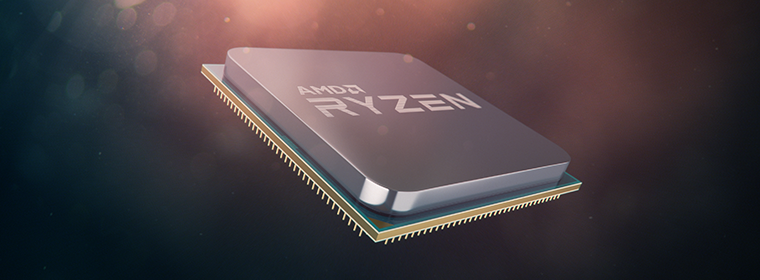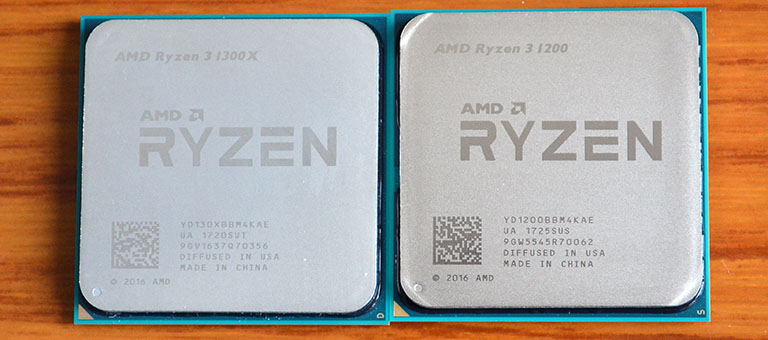Introduction

AMD is showing no signs of slowing up with respect to launching new products throughout 2017. The first half has been dominated by the consumer Ryzen CPUs, while the company's data-center aspirations have had a shot in the arm with Epyc. Both are based on the same underlying Zen architecture, built from the ground up to compete against the best that rival Intel has to offer.
Ryzen is also finding a home in the professional market soon, and a notable inclusion during the Pro release late last month was reference to the more cost-sensitive Ryzen 3 processors. Said processors today come to the consumer market through the release of two chips - the Ryzen 3 1300X and Ryzen 3 1200. Without further ado, let's see just how they fit into the Ryzen landscape.
AMD Ryzen CPU Specifications |
|||||||||
|---|---|---|---|---|---|---|---|---|---|
| Model | Cores / Threads |
TDP |
L3 Cache |
Base Clock |
Turbo Clock |
XFR |
Memory |
Package |
Price |
| AMD Ryzen 7 1800X | 8 / 16 |
95W |
16MB |
3.6GHz |
4.0GHz |
100MHz |
DDR4-2666 |
AM4 |
$499 |
| AMD Ryzen 7 1700X | 8 / 16 |
95W |
16MB |
3.4GHz |
3.8GHz |
100MHz |
DDR4-2666 |
AM4 |
$399 |
| AMD Ryzen 7 1700 | 8 / 16 |
65W |
16MB |
3.0GHz |
3.7GHz |
50MHz |
DDR4-2666 |
AM4 |
$329 |
| AMD Ryzen 5 1600X | 6 / 12 |
95W |
16MB |
3.6GHz |
4.0GHz |
100MHz |
DDR4-2666 |
AM4 |
$249 |
| AMD Ryzen 5 1600 | 6 / 12 |
65W |
16MB |
3.2GHz |
3.6GHz |
100MHz |
DDR4-2666 |
AM4 |
$219 |
| AMD Ryzen 5 1500X | 4 / 8 |
65W |
16MB |
3.5GHz |
3.7GHz |
200MHz |
DDR4-2666 |
AM4 |
$189 |
| AMD Ryzen 5 1400 | 4 / 8 |
65W |
8MB |
3.2GHz |
3.4GHz |
50MHz |
DDR4-2666 |
AM4 |
$169 |
AMD Ryzen 3 1300X | 4 / 4 |
65W |
8MB |
3.5GHz |
3.7GHz |
200MHz |
DDR4-2666 |
AM4 |
$129 |
AMD Ryzen 3 1200 | 4 / 4 |
65W |
8MB |
3.1GHz |
3.4GHz |
50MHz |
DDR4-2666 |
AM4 |
$109 |
The new Ryzens fall into line in expected order. The underlying Zen architecture is based on aggregating two CPU Complexes each composed of four cores connected to each other by low-latency Infinity Fabric, meaning up to eight cores per chip. AMD is able to hit lower core counts by symmetrically disabling cores across each CCX, so the six-core, 12-thread has a 3+3 setup while the four-core, eight-thread Ryzen 5 1500X/1400 has 2+2.
Ryzen 3 takes this a step further by keeping to that 2+2 but then also reducing performance by deactivating the simultaneous threading (SMT) capability. Such deactivation to hit a class of CPU is an expensive way of doing business, as the underlying die is ostensibly the same as the Ryzen 7 chips. If AMD had the engineering efforts in place, Ryzen 3 would use a specific, new die that was much smaller than Ryzen 7, just as GPU manufacturers do when moving down to the stack.
Point is, Ryzen 3 is Ryzen 7 with bits turned off. We don't really care how AMD builds these two low-end Ryzen chips, we only care that they don't compromise elsewhere. Both have access to the same dual-channel DDR4-2,666 memory, have a full complement of PCIe lanes, and have a restrained 65W TDP.
Drilling down into the specs of the two models, the Ryzen 3s are the same from an architecture point of view and only differ with respect to frequencies. Ryzen 3 1300X has a base clock of 3.5GHz, is able to run all cores at 3.6GHz, jump up to 3.7GHz on two cores, while, if you have sufficiently good cooling, climb to 3.9GHz in XFR mode. Guess what, it's pretty much the Ryzen 5 1500X with SMT disabled and access to only half the L3 cache.
Ryzen 3 1200, on the other hand, is more sedate, clocking in at 3.1GHz base and all-core boost, 3.4GHz for two cores running flat out, and 3.45GHz under XFR. Both ship with the Wraith Stealth heatsink in the box. Unlike Intel, all Ryzen chips are unlocked from the factory, so it's possible to eke out more performance with some simple overclocking. We'll investigate just how much later on.
Ryzen 3 is all about hitting the crucial sub-£150 market. We expect the 1300X to retail for around £125 while the 1200 should go for £105. That is very much Intel Core i3 territory, so let's now see how they could potentially stack up.
AMD vs. Intel price comparison |
|||||||||
|---|---|---|---|---|---|---|---|---|---|
| AMD | Price |
Intel |
|||||||
| AMD Ryzen 3 1300X (4 / 4) | $129/$138 |
Intel Core i3-7300 (2 / 4) |
|||||||
| AMD Ryzen 3 1200 (4 / 4) | $109/$117 |
Intel Core i3-7100 (2 / 4) |
|||||||
Ryzen 3 is very much a natural competitor to two of the cheaper Core i3 processors. Much like other Ryzens, we can accurately predict potential performance. Ryzen 3 will likely be faster when all cores are being stressed, but Intel is going to be quicker on light CPU loads. The situation for gaming, though, is more nebulous - we can't say how four full-fat cores of Ryzen will play against the hyperthreaded parts from Intel.
Being even handed, one area where Intel wins out is with due consideration that Core i3 chips feature integrated graphics - Ryzen 3s, like their brethren, all need to be used with discrete GPUs, so bear this in mind when speccing up budget system builds.
The logical supporting chipset for Ryzen 3 is the B350, and a whole gaggle of boards are available for under £100, largely consistent with the Intel B250 chipset that optimally supports Core i3. £250 is enough to pay for a decent-enough CPU and solid motherboard from both guys. Let's now see which is better for your kind of applications.










